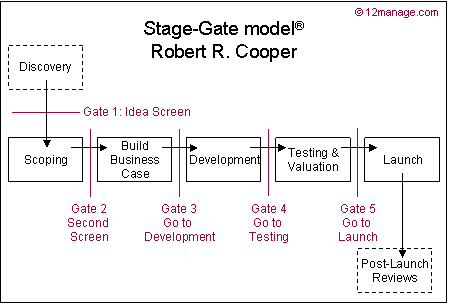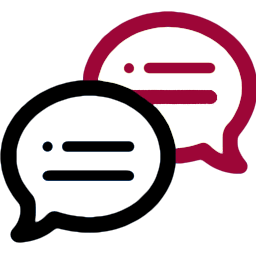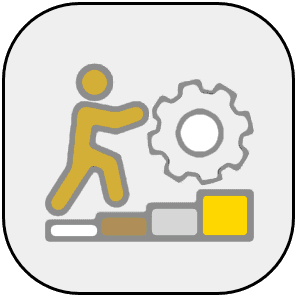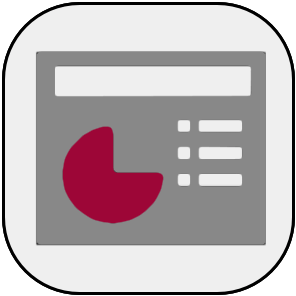What is the Stage-Gate model?
The Stage-Gate method from Robert G. Cooper is an approach that can
be used to make the product development process more effective. It is
a blueprint for managing the new product process. From an idea to launching
a product. In a number of predetermined steps, or stages. Each
stage consists of a set of certain cross-functional and parallel activities
which must be successfully completed prior to obtaining management approval
to proceed to the next stage of product development. The entrance to
each stage is called: a gate. These gates, which are normally
meetings, control the process and serve as:
- Quality control
- Go / Kill check-points. Readiness-checks, Must-Meet criteria,
and Should-Meet criteria.
- Marker for action plan for the next phase.
Stage-Gate is a registered trademark of Product
Development Institute Inc.
Origin of the Stage-Gate methodology. History
The method is based on the experiences, suggestions and observations
of a large number of managers and firms in over 60 cases as observed
by Robert Cooper. The term "Stage-Gate" first appeared in an article
by Cooper in The Journal of Marketing Management, 3, 3, Spring 1988.
An even earlier version can be found in Cooper's book: "Winning at New
Products", 1986.
|
|
Usage of Stage-Gate. Applications
- Product Development, Innovation.
- Component of Portfolio Management.
Steps (stages) in the Stage-Gate model. Process

The Stage-Gate process is preceded by a Discovery stage, which
was added in a later version of the original model which had only 5
phases. It contains pre-work designed to discover opportunities and
to generate new ideas.
- Scoping. A quick, preliminary investigation of each project.
Provides inexpensive information by desk research to enable narrowing
the number of projects.
- Build the Business Case. A much more detailed investigation
by primary marketing and technical research. The business case must
include a product definition, a product justification and a project
plan.
- Development. A detailed design and development of the new
product, along with some simple product tests. Also a production plan
and a market launch plan are developed.
- Testing and Validation. Extensive product tests in both
the marketplace, the lab and the plant.
- Launch. Beginning of full production, marketing and selling.
Market launch, production / operations, distribution, quality assurance.
Post-Launch Reviews are performed.
In reality, it is necessary to drill down further into the sub-activities
to provide detailed and operational instructions for the innovation
team.
Strengths of Stage-Gate methodology. Benefits
- Well-organized innovation can be a source of competitive advantage.
- Accelerated product development. Necessary because of shortening product
life cycles.
- Increased success chance of new products. Prevents poor projects early
and helps to redirect them.
- The model breaks down the complex innovation process in large corporations
in a number of smaller pieces.
- Provides overview, which enables prioritization and focus.
- Integrated market-orientation.
- Cross-functional. Involves input and participation of employees from
various functions in the organization. No separate R&D or Marketing Stage.
But see above Discovery.
- Can be combined with various performance metrics, such as
Net Present Value, etc.
Limitations of Stage-Gate. Disadvantages
- Although within a stage activities can be conducted in parallel, the
Stage-Gate approach is basically sequential (waterfall). Some innovation
experts believe that product development should actually be organized in
parallel, using loops.
- The original Stage-Gate framework did not deal with the Discovery process
and the activities to create new ideas.
- A tension exists between organizing and creativity. Both are very important
within innovation.
Book: Robert G.
Cooper - Product Leadership - Pathways to Profitable Innovation
|
Forum discussions about Product Development.

|
Stage-Gates are Not Limitative
The stage gate model is a widely used model, not only for product innovation but also for all projects. It is part of the Prince2 project management method.
Note that the the phases and number of gat...
 51 |

|
Politics and Innovation in Countries
1. The political leadership has the major say to promote innovation since it controls the environment, and environment is the first thing which gives scope for development of innovation.
2. Depending...
 36  1 comments |

|
Estabish a Distributed Innovation Group
In an article entitled "Teaming Up to Crack Innovation and Enterprise Integration, James Cash, Michael Earl and Robert Morison suggest to establish a Distributed Innovation Group (DIG) to deal with th...
 14  1 comments |
|
|
|
Courses about Product Development.

Beginners Course
|

Advanced Course
|

Course for Experts
|
|
|
|
The best, top-rated topics about Product Development. Here you will find the most valuable ideas and practical suggestions.
|
🥇
|
Fostering Innovation by Leaders
The main challenge to improve innovation is how to develop leaders which stimulate and sustain innovation instead of just looking at the bottom line figures.
An innovative culture is the consequence ...
 33  15 comments
|
|
🥈
|
Tip: 10 Red Flags for Innovation
Interesting statement for discussion in Business Week:
"There's no surefire way to guarantee success in innovation".
Stefan Lindegaard offers 10 helpful suggestions or common pitfalls to avoid." Ver...
 32  11 comments
|
|
|
|
Advanced insights about Product Development. Here you will find professional advices by experts.

Consultancy Tips
|

Teaching Tips
|

Practical Implementation Tips
|
|
|

|
Success Factors for Stage-Gate Implementation Imlementing Stage-Gate Processes
In his article “Implementing a Stage-Gate Process: A Multi-Company Perspective”, O’ Connor analyzed several cases...
|

|
How to Find Good Product Ideas? List of 10 Approaches Discovering New-Product Ideas, Creative Approaches
In his book “Product Leadership: Creating and Launching Superior New Products”, Robert Cooper suggests following ten way...
|

|
Stage-Gate Implementation CSFs Implementing the Stage-Gate Process
So far Stage-Gate method has been widely recognized as the best New Product Development Process, although there can be s...
|

|
Innovation Pitfalls Avoiding Innovation Traps
Note that Stage Gate is focused mainly on the innovation PROCESS. Harvard Professor R. Moss Kanter describes 4 common in...
|

|
Advantages and Disadvantages of Stages and Gates Innovation Management, Stage-Gate Implementation
Advantages:
+ Stage - Gate processes have been highly appreciated as they tend to confine investment in the next stage ...
|

|
Setting up a Stage-Gate Organization. Best Practices Stage-Gate Roles and Responsibilities
To obtain successful outcomes from Stage-Gate it is essential to define roles and responsibilities of all people involve...
|

|
Benefits of Outsourcing Innovation Improving Innovation Performance
Michael A. Stanko, Jonathan D. Bohlmann and Roger J. Calantone (“Outsourcing Innovation”, Executive Adviser, November 20...
|

|
Innovating Bottom-up or Top-down Corporate Innovation Approaches
I just read an interesting article by professor Deschamps on encouraging innovation within large organizations. Deschamp...
|

|
Key Challenges of Internet Age for Management and for Product and Service Development R&D, Product Development, Service Development, Strategy, Marketing, Innovation, Visioning
The Internet age represents a huge challenge for most businesses. Why?
Because the Internet, wireless devices such as m...
|

|
Recent Innovation Trends | New Innovation Types Open innovation, User Innovation, Value Innovation, Bottom-up Innovation
Roland Bel (2012) outlines and explains four types of innovations that have become more and more important since the las...
|

|
How to Detect Consumer Needs that are Unmet? Product Innovation, New Product Development, Innovation Strategy
In their article New Business Models in Emerging Markets" (Harvard Business Review, January-February 2011), Matthew J. E...
|

|
Alternatives to Stage-Gate Approach Innvation Management
An alternative product development technique called "The Bounding Box" has been recently pionereed by Phd Laura Doyle. T...
|

|
Cooper's Innovation Diamond (tm) More Factors Leading to Succesful Product Innovation
Also look at Cooper's Innovation Diamond (2005) with (besides the Stage-Gate System) three more factors leading to succe...
|

|
Another Product Launch Method: 4 I's Stage-Gate Alternatives
I use a Process of 4 I's when coaching planning processes. The process is similar to S/G above but the 4-I's are easier...
|

|
When Should a Firm Consider to Outsource Innovation? Outsourcing Best Practices, Innovation
According to Michael A. Stanko, Jonathan D. Bohlmann and Roger J. Calantone in the article “Outsourcing Innovation” (Exe...
|

|
Pitfalls and Obstacles in Product Development Strategy Product Development, Product Portfolio Management
Although product development can be an important growth strategy, it is necessary to keep in mind that several factors t...
|

|
Innovating Under the Radar Avoiding 5 Obstacles to Major Innovation
If somewhere below in a large corporation an innovator has a very bright, daring, promising but for some perhaps also th...
|

|
A Next-Generation Stage Gate Approach Innovation Funnel Management, Innovation Decision-making, Innovation Risk Management
Whereas most Stage Gate models have a qualitative, non-financial orientation, Strat/Assess is a funnel innovation model,...
|

|
How Culture Levels Explain Failures in Organizational Learning and Innovation Improving Organizational Learning, Organizational Innovation, Changing Organization Cultures
Schein (as cited by Bertagni et al., 2010) tries to elaborate on the question why organizational innovations often fail ...
|

|
Key Behaviors of Innovative Organizations Innovation Management, Culture Change, Organizational Change, Innovative Culture, Organizational Culture
Many large-scale attempts to make organizations more innovative are experiencing organizational inertia, barriers and/or...
|

|
Alternate Product Launch Method Stage-Gate Alternatives
Steelcase CEO James P. Hackett describes the following product launch stages:
- THINK (Ponder, Query, Read and researc...
|

|
The Mandate of NPD and the Degree of Change that is Required New Product Development, NPD Process Improvement
When using the Stage-Gate process, a strategic implementation plan is advisable to avoid stakeholders’ disappointment re...
|

|
Control and Measurement Method Tracking Stage-Gate Performance
To deeply understand performance and effects of Stage-Gate as NPD Process on an organization, an effective measurement a...
|

|
Characteristics of Organizations with an IT-driven Business Transformation Strategy IT-driven Strategy, IT-led Strategy, Competitive Potential, Innovation Accelerators, Disruptive Innovation
Today organizations need to move quickly through a wide range of business transformations, often caused by new and compl...
|

|
How to Lead an Innovation Team Best Practices, Innovation Team Management
In order to become a great innovation team leader, Ram Charan suggests in the article "P&G's Innovation Culture" (strate...
|

|
How to Design Experiments to Support Decision-making on Strategic Innovations Strategic Innovation, Strategic Decision-making, Strategic Experimenting, Experiments, Strategic Testing, Innovation Tes
The probability of success of a major innovation is difficult to assess. Statistics and other datasets only provide info...
|

|
Creating Organizations to Produce Breakthrough Innovations Best Practices, Critical Factors, Creating an Organization to lead Radical Innovation
Since 50 years, the Pentagon’s Defense Advanced Research Projects Agency (DARPA) has been very successful in producing a...
|

|
The Role of Diversity in Personal Traits on Innovation and Innovativeness Innovation, Increasing Organizational Innovativeness
New research by Hewlett, Marshall and Sherbin proves that diversity (of personal and team traits) drives innovation and ...
|

|
A Closer Look at How Change and Innovation Decisions are Made Decision-making on Organizational Change, Innovation Decision-making, Contingent, Participative Decision-making
Kim, T (2015) elaborates on decision making on "non-routines" or innovations. According to him, non-routines can be seen...
|

|
What Makes a Company Innovative? Innovation Best Practices, R&D Best Practices, Corporate Innovation
A Futurethink Innovation Tracker Survey (2006) mentions:
- Ability to create a climate that continuously fosters innov...
|

|
Three Critical Capabilities in Developing a Strategic Corporate Disruptive Innovation Competence (Disruptive) Innovation Competence, Strategic Innovation Capability, Corporate Strategy, Innovation Leadership
Skarzynski and Rufat-Latre (2011) discovered that the successes of disruptive innovators are driven by 3 critical capabi...
|
|
|
|
Various sources of information regarding Product Development. Here you will find powerpoints, videos, news, etc. to use in your own lectures and workshops.

|
Improving Product Development Processes to Manage Development Risk Innovation of Product Development Processes
To create new products, firms employ a product development process (PDP) to generate new product concepts, to translate ...
|

|
Stage Gate Approval Template Stage Gate Meetings
Some good Stage Gate approval templates along with some useful forms by Padraig Clarke....
|

|
How to Manage Creativity in Organizations Innovation Management, Managing Creativity, Managing Creative People, Fostering Creativity in Organizations, Creativity
This presentation elaborates on the management of creativity in organizations, and includes the following sections:
1. ...
|

|
3 Key Benefits of Cross-Functional Teams for Innovation Innovation, Team Work, Multicultural Teams, Bureaucracy, Multi-Functional Teams
In innovation you need a team of people with the right mix: the members should come from different departments like Mark...
|

|
Introduction to Managing Creativity and Innovation Innovation Management, Managing Innovation, Managing Innovative Employees, Managing Creative Employees
Presentation about Innovation and Creativity, thereby mainly focusing on creativity in organizations. The presentation i...
|

|
Concept Testing and Conjoint Analysis for New Products Concept Test, Concept Statement, Conjoint Analysis, Product Design, Product Innovation
Presentation about concept testing and conjoint analysis, including the following sections:
1. Evaluating with Customer...
|

|
Stage-Gate Diagram Innovation Management
Download and edit this 12manage PowerPoint graphic for limited personal, educational and business use.
Republishing in ...
|
|
|
|
Useful tools regarding Product Development.

News
|

Videos
|

Presentations
|
| |

Books
|

Academic
|

More
|
|
|
|
Compare with Stage-Gate:
Forget Borrow Learn
| Portfolio Management |
DICE Framework |
Team Management
Profile |
Appreciative Inquiry
| Brainstorming |
Six Thinking Hats
| Product Life Cycle
Return to Management Hub: Change & Organization | Decision-making & Valuation | Marketing & Sales
| Strategy & Innovation
More Management Methods, Models and Theory
|
|
|














